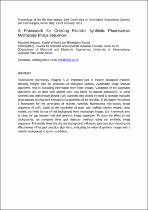 ResearchSpace
ResearchSpace
A framework for creating realistic synthetic fluorescence microscopy image sequences
JavaScript is disabled for your browser. Some features of this site may not work without it.
- ResearchSpace
- →
- Research Publications/Outputs
- →
- Conference Publications
- →
- View Item
| dc.contributor.author |
Mabaso, M

|
|
| dc.contributor.author |
Withey, Daniel J

|
|
| dc.contributor.author |
Twala, B

|
|
| dc.date.accessioned | 2016-07-11T10:49:06Z | |
| dc.date.available | 2016-07-11T10:49:06Z | |
| dc.date.issued | 2016-02 | |
| dc.identifier.citation | Mabaso, M. Withey, D.J. and Twala, B. 2016. A framework for creating realistic synthetic fluorescence microscopy image sequences. In: Proceedings of the 9th International Joint Conference on Biomedical Engineering Systems and Technologies, Rome, Italy. 21-23 February, 2016 | en_US |
| dc.identifier.isbn | 978-989-758-170-0 | |
| dc.identifier.uri | DOI: 10.5220/0005699200850092 | |
| dc.identifier.uri | http://hdl.handle.net/10204/8621 | |
| dc.description | Proceedings of the 9th International Joint Conference on Biomedical Engineering Systems and Technologies, Rome, Italy. 21-23 February, 2016. Due to copyright restrictions, the attached PDF file only contains the abstract of the full text item. For access to the full text item, please consult the publisher's website | en_US |
| dc.description.abstract | Fluorescence microscopy imaging is an important tool in modern biological research, allowing insights into the processes of biological systems. Automated image analysis algorithms help in extracting information from these images. Validation of the automated algorithms can be done with ground truth data based on manual annotations, or using synthetic data with known ground truth. Synthetic data avoids the need to annotate manually large datasets but may lack important characteristics of the real data. In this paper, we present a framework for the generation of realistic synthetic fluorescence microscopy image sequences of cells, based on the simulation of spots with realistic motion models, noise models, and with the use of real background from microscopy images. Our framework aims to close the gap between real and synthetic image sequences. To study the effect of real backgrounds, we compared three spot detection methods using our synthetic image sequences. The results show that the real background influences spot detection, reducing the effectiveness of the spot detection algorithms, indicating the value of synthetic images with a realistic background in system validation. | en_US |
| dc.language.iso | en | en_US |
| dc.publisher | IEEE Xplore | en_US |
| dc.relation.ispartofseries | Workflow;16612 | |
| dc.subject | Synthetic image sequences | en_US |
| dc.subject | Microscopy bioimaging | en_US |
| dc.subject | Spot detection | en_US |
| dc.title | A framework for creating realistic synthetic fluorescence microscopy image sequences | en_US |
| dc.type | Conference Presentation | en_US |
| dc.identifier.apacitation | Mabaso, M., Withey, D. J., & Twala, B. (2016). A framework for creating realistic synthetic fluorescence microscopy image sequences. IEEE Xplore. http://hdl.handle.net/10204/8621 | en_ZA |
| dc.identifier.chicagocitation | Mabaso, M, Daniel J Withey, and B Twala. "A framework for creating realistic synthetic fluorescence microscopy image sequences." (2016): http://hdl.handle.net/10204/8621 | en_ZA |
| dc.identifier.vancouvercitation | Mabaso M, Withey DJ, Twala B, A framework for creating realistic synthetic fluorescence microscopy image sequences; IEEE Xplore; 2016. http://hdl.handle.net/10204/8621 . | en_ZA |
| dc.identifier.ris | TY - Conference Presentation AU - Mabaso, M AU - Withey, Daniel J AU - Twala, B AB - Fluorescence microscopy imaging is an important tool in modern biological research, allowing insights into the processes of biological systems. Automated image analysis algorithms help in extracting information from these images. Validation of the automated algorithms can be done with ground truth data based on manual annotations, or using synthetic data with known ground truth. Synthetic data avoids the need to annotate manually large datasets but may lack important characteristics of the real data. In this paper, we present a framework for the generation of realistic synthetic fluorescence microscopy image sequences of cells, based on the simulation of spots with realistic motion models, noise models, and with the use of real background from microscopy images. Our framework aims to close the gap between real and synthetic image sequences. To study the effect of real backgrounds, we compared three spot detection methods using our synthetic image sequences. The results show that the real background influences spot detection, reducing the effectiveness of the spot detection algorithms, indicating the value of synthetic images with a realistic background in system validation. DA - 2016-02 DB - ResearchSpace DP - CSIR KW - Synthetic image sequences KW - Microscopy bioimaging KW - Spot detection LK - https://researchspace.csir.co.za PY - 2016 SM - 978-989-758-170-0 T1 - A framework for creating realistic synthetic fluorescence microscopy image sequences TI - A framework for creating realistic synthetic fluorescence microscopy image sequences UR - http://hdl.handle.net/10204/8621 ER - | en_ZA |





